September 30, 2009 — From a stuffed lion to a faux film poster, a colorful badge to a red clown's nose, the three cosmonauts who launched early Wednesday morning to the International Space Station (ISS) outfitted their Soyuz capsule and spacesuits with symbols representing their lives on Earth and missions in orbit.
Russian cosmonaut Maxim Suraev, American astronaut Jeffrey Williams and Canadian spaceflight participant Guy Laliberté lifted off on-board Soyuz TMA-16 from Russia's Baikonur Cosmodrome in Kazakhstan at 2:14 a.m. CDT. They will arrive at the station on Friday, where Suraev and Williams will begin a six month stay as members of the outpost's 21st and 22nd expedition crews.
A circus performer-turned-entrepreneur and philanthropist, Laliberté will return to Earth after almost two weeks in space, having paid upwards of $35 million to the U.S. space tourism firm Space Adventures to be their seventh orbital client to fly.
Have clown nose, will travel
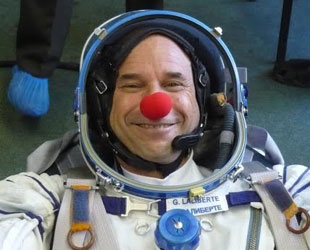
| Spaceflight participant Guy Laliberté during a preflight fit check of his spacesuit... and clown nose. (Cirque du Soleil) |
Laliberté began his professional life as a street performer, walking on stilts and fire eating, before co-founding Cirque du Soleil in 1984. The Canadian circus company stages a "mix of circus arts and street entertainment" with touring and permanent shows around the world.
From the start of his training, Laliberté made it clear how his inner-performer would manifest itself in space; in fact, he made it as clear as the red clown nose on his face.
"I'm not a professional cosmonaut, an astronaut, so what I'm bringing up there is what I am. And what I am is an artist, a creative," he said, displaying the costume nose that he had been seen wearing over the past few months and which he plans to don in space.
Laliberté packed nine of the noses for his journey, one for each of his crew mates and himself while aboard the ISS.
"We're building up to nine and eventually there may be a million up there!" he boasted.
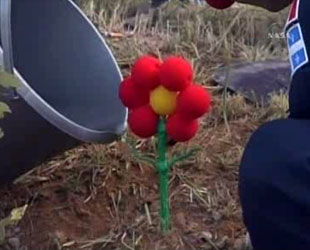
| Laliberté's clown nose flower is watered. (NASA TV) |
In addition to wearing the noses, Laliberté used them to fulfill a long Russian tradition of planting a tree for each cosmonaut. During the customary ceremony held with his crew mates, Laliberté revealed a flower that was made of red nose petals and a yellow nose for its center.
After planting the "flower", the ground surrounding it was watered, which served to couple Laliberté's two symbols.
Just as the clown nose represented who he is, the drop of water symbolizes the purpose of his space mission.
Laliberté's "Poetic Social Mission" revolves around a two hour live webcast scheduled for October 9 promoting the importance of access to clean water for all. Organized by his non-profit ONE DROP Foundation, the broadcast will feature the performance of a poetic fairy tale about water as staged in 14 cities around the world by artists and notable individuals such as Shakira, Peter Gabriel, U2, and former U.S. Vice President Al Gore, as well as, of course, Laliberté from aboard the station.

| Laliberté personal mission patch. (Cirque du Soleil) |
Laliberté's personal mission patch highlights his cause by depicting a water drop encompassing the Earth. Around the drop are other symbols of his spaceflight including the Soyuz rocket taking him to space and the ISS, as well as the flags of his and his crew mates' nations.
Kids' stuff
In addition to wearing his own patch, Laliberté's spacesuit also includes the badge designed for the TMA-16 flight.
Continuing a recent tradition that began earlier this year, Suraev and Williams based their Soyuz insignia on the art submitted by 14-year old Nastya Mestyashova from the Orenburg region of Russia. Mestyashova entered a contest first held by Roscosmos, Russia's Federal Space Agency, in support of the Soyuz TMA-14 mission, from which her drawing was selected by Suraev and Williams.
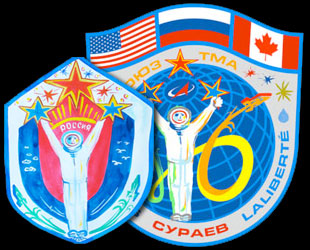
| Mestyashova's art and Soyuz TMA-16 patch. (Roscosmos) |
Her design, which featured a cosmonaut and three large stars -- one for each crew member -- was incorporated to form the Soyuz TMA-16 patch. The final version also has the American, Russian and Canadian flags, as well as a growing plant that gradually transforms into a fiery rocket trail and a spacecraft, which forms the Roman numeral and mission designation "16".
As her prize, Mestyashova was invited to the launch to witness her artwork fly.
Suraev also honored another tradition involving children, inviting his two daughters to select the flight's mascot -- a plush toy lion hung in the Soyuz spacecraft that served as a "zero-g indicator" when it began to float.
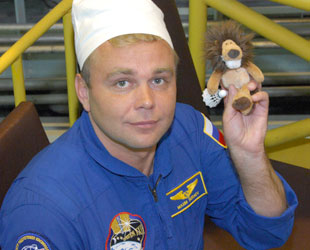
| Suraev displays his daughters' toy lion. (RSC Energia) |
His young daughters kept the lion under their pillows to ensure that it smelled of home. "It's like part of their soul coming with me," Suraev told collectSPACE.
Mocking movie memories
Before leaving for space, the crew together recognized a milestone for another cosmonaut tradition said to bring good luck to the mission.
"We pointed out that this year is the 40th anniversary when 'The White Sun of the Desert' movie was made and we have a tradition observed unfailingly that... both the prime and back-up crews will watch it," said Suraev during a pre-flight press conference.
To honor the 1969 film, a comedy about a Russian soldier fighting in Central Asia, the crew had produced a parody of its poster, replacing their faces for those of the actors and their Soyuz for the film's ship.
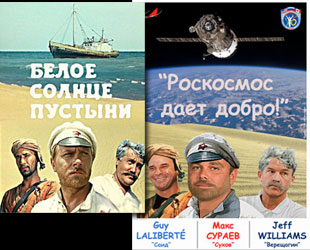
| Original and crew parody versions of "The White Sun of the Desert" movie poster (Roscosmos) |
Laliberté also arranged some special apparel, which he and his two crew mates revealed at the close of the press conference.
"Also Guy made t-shirts," Suraev announced, as the trio unzipped their flight suits to reveal their likenesses from the poster printed on their chests.
"You have to make [a] funny picture," said Guy, letting his inner clown shine through.
